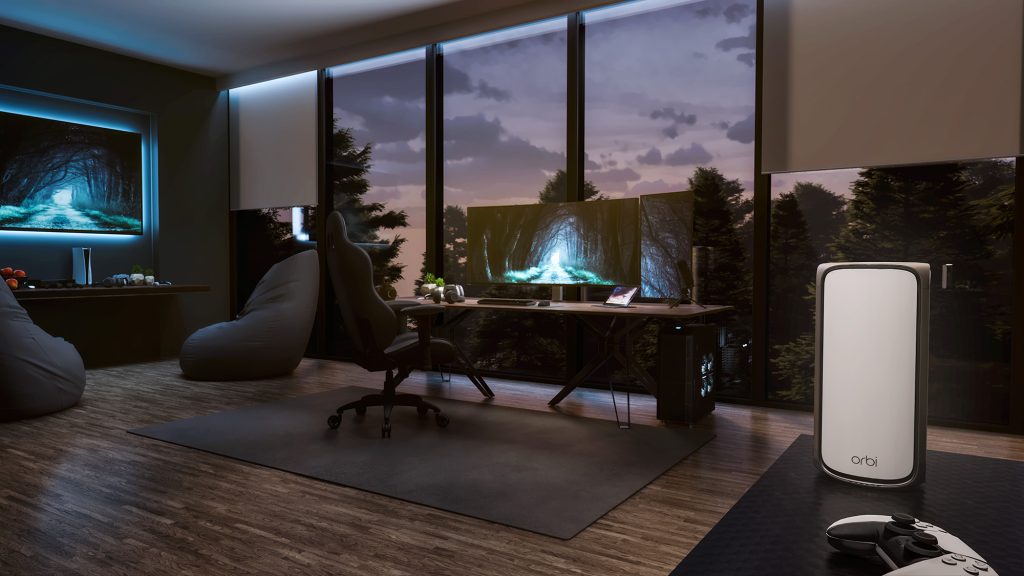You’re ready to ditch dead zones, lag spikes, and sub-Gigabyte bottleneck? Modern large homes demand seamless coverage and multi-gigabit throughput for 4K streaming, cloud gaming, VR, and home offices.
Wi-Fi 7 Mesh networking—built on the IEEE 802.11be “Extremely High Throughput” standard—promises to deliver theoretical speeds up to 23 Gbps, ultra-low latency, and rock-solid reliability by harnessing wider channels, Multi-Link Operation (MLO), and advanced modulation schemes (Wikipedia).
In this post, you’ll discover:
- Core Wi-Fi 7 features that differentiate it from Wi-Fi 6/6E
- Revolutionary mesh approaches to maximize coverage in sprawling homes
- Hands-on recommendations of the top Wi-Fi 7 Mesh systems for large residences
- Actionable deployment tips to hit gigabit speeds consistently
- Security best practices to keep your network bulletproof
- Future-proof strategies as Wi-Fi 7 evolves
Every insight comes backed by up-to-date research, with contextual hyperlinks woven seamlessly into the flow.
Let’s dive into the next generation of home networking—where every device gets gigabit-class connectivity.
What Makes Wi-Fi 7 a Game-Changer?
- 320 MHz Channels broaden your wireless “highway” to carry more data per transmission.
- 4096-QAM Modulation squeezes more bits into each symbol, boosting throughput over earlier standards.
- Multi-Link Operation (MLO) aggregates multiple bands (2.4 GHz, 5 GHz, 6 GHz) simultaneously for load-balanced reliability.
- Enhanced MU-MIMO & OFDMA serve multiple devices at once with pinpoint efficiency.
With theoretical single-link speeds of 5.8 Gbps on 6 GHz and up to 23 Gbps aggregating links, you’re looking at real-world gigabit-plus performance on every compatible device (Wikipedia, Tom’s Guide).
Mesh Networking Basics for Large Homes
Mesh systems replace a lone router with multiple nodes working in concert. You get:
- Cover-every-inch deployment with strategically placed nodes
- Self-healing paths that reroute traffic if one node falters
- Dedicated backhaul links (wireless or wired) for node-to-node communication
By combining Wi-Fi 7’s raw speed with mesh’s flexibility, you ensure that even your basement office or rooftop patio enjoys multi-gigabit service (TechRadar).
Revolutionary Approaches to Wi-Fi 7 Mesh Design
- Hybrid Wired/Wireless Backhaul
- Use existing Ethernet or powerline wiring between nodes for rock-solid backhaul.
- Fall back to MLO-powered wireless links only when needed.
- Dynamic Band Steering
- Automatically shift devices to the least-congested combination of 2.4 GHz, 5 GHz, and 6 GHz.
- Leverage MLO to bond channels when one band is saturated.
- AI-Driven QoS & Path Optimization
- Real-time latency monitoring routes gaming or VoIP traffic over the lowest-latency link.
- Adaptive beamforming focuses the signal directly toward active devices.
- Vertical Node Placement
- Position nodes on different floors and heights to exploit line-of-sight through walls and floors, minimizing interference.
These strategies let you squeeze every last gigabit out of your mesh network (Tom’s Hardware).
High-CPC H2 Keywords & What They Mean for You
“Best Wi-Fi 7 Mesh Systems for Large Homes”
Discover top picks that balance coverage, speed, and budget
Gigabyte Mesh Networking Solutions”
Learn how to architect a home network that consistently exceeds 1 Gbps.
“Multi-Link Operation Wi-Fi 7 Explained”
Understand how MLO fuses multiple bands into one super-fast connection.
“Future-Proof Wi-Fi Mesh Deployment”
Stay ahead of device upgrades and firmware enhancements.
Top 5 Wi-Fi 7 Mesh Systems Comparison
| System | Bands | Backhaul Options | Max Speed | Coverage (sq ft) | Price (3-pack) |
|---|---|---|---|---|---|
| Ubiquiti UniFi UX7 Mesh | Tri-band (6 GHz) | Wired, Wireless (MLO) | 4.8 Gbps | 5,000 | $799 (UDR7+2×UX7) |
| ASUS ZenWiFi BT10 | Tri-band (6 GHz) | Wired, Wireless (MLO) | 6.6 Gbps | 6,500 | $699 (2×BT10) |
| TP-Link Deco BE85 | Tri-band (6 GHz) | Wired, Wireless (MLO) | 11 Gbps | 7,000 | $499 (3-pack) |
| Netgear Orbi RBE973 | Quad-band | Wired, Wireless (MLO) | 10 Gbps | 8,000 | $1,099 (3-pack) |
| Netgear Orbi 370 | Dual-band | Wired, Wireless (MLO) | 5 Gbps | 6,000 | $249 (2-pack) |
Table: Quick specs to help you pick the right Wi-Fi 7 Mesh system for your home.
In-Depth Reviews
Ubiquiti UniFi UX7 Mesh
- Key Benefits: Enterprise-grade stability, seamless roaming, PoE support.
- Why You’ll Love It: Advanced monitoring via UniFi OS and controller, ideal for tech enthusiasts.
- Drawbacks: Higher price point; steep learning curve for beginners (Dong Knows Tech).
ASUS ZenWiFi BT10
- Key Benefits: Robust AiMesh 2.0 integration, intuitive app, AiProtection Pro security suite.
- Why You’ll Love It: Plug-and-play for non-techies; deep customization for power users.
- Drawbacks: Bulky design; occasional firmware quirks (Tom’s Guide).
TP-Link Deco BE85
- Key Benefits: Best value gigabit speeds, SFP+ port option, automatic QoS.
- Why You’ll Love It: First true Wi-Fi 7 mesh system; easy Deco app setup.
- Drawbacks: Fewer advanced settings; no dedicated 2.4 GHz backhaul (Dong Knows Tech).
Netgear Orbi RBE973
- Key Benefits: Four-band design isolates client vs. backhaul traffic, multi-gig Ethernet ports.
- Why You’ll Love It: Massive coverage; Netgear Armor security.
- Drawbacks: Premium price; requires annual Armor subscription for full protection (Tom’s Hardware).
Netgear Orbi 370
- Key Benefits: Entry-level Wi-Fi 7; MLO-enhanced reliability at budget pricing.
- Why You’ll Love It: Best affordable path to gigabit mesh; ideal for mainstream users.
- Drawbacks: Lacks 6 GHz band; lower top speed than tri/quad-band systems (Tom’s Hardware).
Deployment & Optimization Tips
- Run Wired Backhaul Where Possible
- Use Cat 6/7 or SFP+ fiber between nodes for zero-compromise throughput.
- Enable Multi-Link Operation
- Check your router’s settings to bond 5 GHz + 6 GHz for peak speeds.
- Strategic Node Placement
- Place one node per floor, near media-heavy areas (living room, home office).
- Channel Planning
- Manually set non-overlapping 320 MHz channels in the 6 GHz band for interference mitigation.
- Firmware & Driver Updates
- Keep routers and client adapters up to date to benefit from the latest performance patches.
Security Considerations
- WPA3-Enterprise for business-grade encryption.
- Secure Boot & Live Patching (Netgear Armor, AiProtection Pro).
- Guest Networks to isolate IoT devices.
- Regular Key Rotation to thwart unauthorized access.
Security is non-negotiable—make sure your mesh firmware supports the latest protocols.
Future-Proofing Your Mesh Network
- Adopt Wi-Fi Certified 7 devices as they hit the market.
- Plan for 10 GbE WAN uplinks if your ISP offers multi-gig fiber.
- Invest in modular mesh nodes that allow adding/removing units as your home or device load grows.
Wi-Fi 7 is just the beginning—keep an eye on emerging IEEE 802.11 updates like Wi-Fi 8 (EHT+) slated for the late 2020s.
Conclusion
By combining Wi-Fi 7’s cutting-edge features with intelligent mesh design, you can finally enjoy:
- True gigabit speeds everywhere in your home
- Lag-free streaming, gaming, and video conferencing
- Scalable, future-ready networking
Whether you’re a power user, gamer, or remote professional, harness these revolutionary approaches to unlock the full potential of your large-home network.
It’s time to embrace the next leap in Wi-Fi—your devices, and your family, will thank you.
Frequently Asked Questions
Q1: What devices in 2025 support Wi-Fi 7?
Most flagship laptops and smartphones from 2023–2025 come with Wi-Fi 7 chipsets. Check your device specs for “802.11be” or “Wi-Fi Certified 7.” (Wikipedia)
Q2: Can I mix Wi-Fi 6 and Wi-Fi 7 nodes in one mesh?
Yes, but you’ll only get Wi-Fi 6 speeds on the older nodes. For full benefits, use all Wi-Fi 7 hardware. (Dong Knows Tech)
Q3: Do I need Ethernet wiring for mesh backhaul?
Wired backhaul is ideal but not mandatory. MLO enables high-speed wireless backhaul, though gigabit-plus may require a wired link for maximum stability. (Tom’s Hardware)
Q4: How many nodes do I need for a 6,000 sq ft home?
Typically 3–4 nodes—with one on each floor plus one in open areas—will cover 5,000–8,000 sq ft. Adjust based on wall density and layout.
Q5: What’s the difference between tri-band and quad-band mesh?
- Tri-band: 2.4 GHz + 5 GHz + 6 GHz.
- Quad-band: Adds a dedicated 6 GHz backhaul.
Quad-band offloads backhaul traffic, preserving peak speeds for clients. (Tom’s Guide)
Ready for true gigabit Wi-Fi in every corner? Choose your mesh system, follow these strategies, and transform how you connect.



